A lengthy and technical
press release reveals details about the planners' exhibit design
philosophy.
| The Scott
exhibit is located on the Pool of Industry -- the prestige "dress
circle" of the industrial section of the Fair. Walking up
the central mall from the Unisphere symbol, a visitor will see
first the massive building of the Bell Telephone Company, located
at the apex of the circle. To the right, the eye catches the
General Electric Pavilion, and then, a little higher up and about
half-way around, a fifty-foot tower, made of two intersecting
cones of glistening gold cables supported by huge stained wooden
beams, arrests the attention. |
| This is Scott's
entrance tower -- a provocative, geometric sculpture suggesting
trees, growth and progress. Reaching up from a wooden platform
base suspended over a running pool, the tower grows out of a
beautifully landscaped site which features evergreen and deciduous
trees of 10, 15, 20 feet in height. The atmosphere of the exhibit
area is one of park-like tranquility; a cool place to rest and
relax in uncommercial surroundings. |
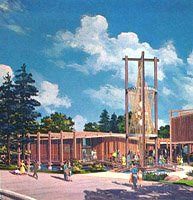 |
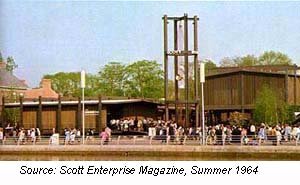 |
Back from
the tower, on the left, the visitor sees a low, wide, wooden
structure of California "mountain lodge" styling, characterized
by a low sloping roof which overhangs the stained-wood walls
by several feet. This building houses the exhibit proper entitled
"The Scott Enchanted Forest". |
| Looking straight
ahead through the tower cables, the visitor sees a smaller structure
of similar architectural style, but raised 14 feet off the ground.
This is the pavilion office, and its elevation permits the aspect
of the visitor to continue towards the paths and landscaped areas
beyond. To the rear of the exhibit area, a third building of
the same design houses comfortable restroom facilities. |
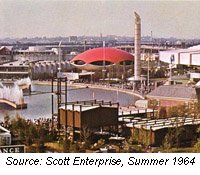 |
|
The visitor
to the main exhibit building enters a wooded setting of trees,
plants, a flowing stream -- a forest within a forest. The surroundings
are extended in breadth and dimension through the use of a perfectly
blended color photo-transparency in the background.
A voice
invites visitors to explore two great mysteries in Scott's business
-- first, the mystery of the enchanted forest, where a thousand
magic ingredients are waiting for scientists to unlock them;
and second, the mystery of the Goddess of the Market Place, the
American housewife; whose whim is Scott's law, whose favor it
courts. Then, a written message appears, unrolling between two
trees on an invisible glass teleprompter screen. This message
sets the theme for the exhibit, relates trees and women, and
tells why Scott cares about both.
Proceeding
on, the visitor becomes aware of a tinted wall mural on the right,
sweeping ahead and blending into another woods-color transparency
which melts into foliage.
|
| One of the
unusual effects created for the exhibit will first be seen in
this entry area -- that of a metallic representation of leaves
which serves as the ceiling throughout the exhibit building.
These leaves will be vertically placed rectangles of metal annealed
with white paint and arranged at slightly varying heights to
create a somewhat irregular effect. They will be illuminated
by hidden lights which will produce rich oranges and greens in
the realistic forest section, and brighter, gayer colors in the
more modern section beyond where bolder product display techniques
are employed. All tree effects, realistic as well as abstract,
will rise from the floor to the ceiling in columnar form. |
|
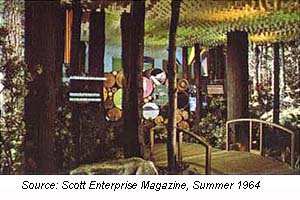
|
Further along
the path, the visitor encounters a waterfall cascading out of
a natural setting and running into a stream which cuts through
the exhibit and out of the building. In this continuation of
the forest and foliage, a wooden arched bridge carries the walkway
across the stream and on into the exhibit. |
|
Before
crossing the bridge, the visitor is attracted by another message,
on the right this time, briefly recounting the story of woodlands
operations, their scope as the primary source of raw materials.
The point will be made that the timber is a crop which Scott
scientifically manages and harvests, not a resource that is cut
and lost forever. The theme in this section emphasizes why and
how natural resources are used, yet protected for future generations.
The message also explains that along with making top quality
products for consumers and jobs for thousands of people, by-products
of good industrial forest management are wildlife, water and
recreational opportunities.
In photo-mural
treatment, a kaleidoscope of such woodland activities as cutting,
harvesting, tree growing and floating the wood to the mill by
river will be dramatized in black and white action photographs
set out from the tinted-forest setting behind.
Thus lead
on by the series of forestry pictures on the right, the visitor
proceeds across the arched bridge still very much in the woodland
setting but now attracted by a visual change of pace up ahead
which leads her from the forest into a more man-made, structured
world smacking of giant machines, forceful processes which transform
raw materials into more usable forms.
The trees,
realistic 'till now, are transformed into a more stylized design,
still retaining their cylindrical shapes, but taking on new colors
and bark configuration. Man's magical hand is making itself felt
on this raw product.
Beyond
the bridge another message appears telling the story of recreational
by-products of forest management -- hunting, camping, fishing.
This will be interwoven with the story of Scott's use of water.
Water is the lifeblood of the paper industry's business and millions
of dollars are spent to protect it, use it and return it to the
nation's streams for re-use.
|
| This message
then leads directly to the next major visual element -- apparently
a stack of log ends pointed toward the visitor, but providing
a series of circular picture frames showing a sequence of scenes
including a log flow in a river, barking, chipping, pulping,
bleaching. |
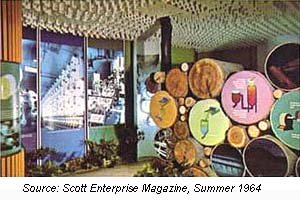 |
|
The pictures
flash on in series using colors, backlighting and projected word
descriptions of the processes where appropriate.
The visitor
will then be diverted to the left, where a spectacular cylindrically-shaped
exhibit device rotates 360 degrees describing pictorially, schematically
and verbally the papermaking process from headbox to drier section
in terms a ten-year-old child can understand.
The papermaking
story is continued into the converting process through a series
of dramatic color photographs. After about ten feet of these
photos -- three in number -- another cylindrical exhibit technique
will picture and explain Scott's quality control concept -- the
men who perform the job, testing stations, the relationship of
this function to consumers.
In the
corner of the exhibit building, the visitor is next attracted
by an exhibit location focused solely on women. This is midway
in the exhibit and at this point Scott salutes the American housewife
with an entertaining and provocative exhibit which shows her
in her many roles -- doing dishes, laundry, ironing, harassed
by kids, chief chef, clean-up detail -- the everyday world of
a busy housewife. A graphic symbol representative of the Goddess
of the Market Place is established, and will be utilized throughout
the rest of the exhibit.
|
 |
Turning from
Scott's salute to her, the visitor will be attracted toward a
"corridor of products," and array of exhibits displaying
the bright, modern, colorful, convenience items which Scott makes
especially for her. The mood is multi-colored with pinks and
pastels, gay packages and products, all of which stretch out
before her as though at her feet. |
|
Each of
five product exhibits will be unique in its technique and general
appearance except for the continued use of the cylindrical or
abstract tree trunk shape and the now familiar "Goddess"
symbol. Each exhibit will have the similar net effect, however,
of putting a Scott product or line of products in a service context
rather than simply showcasing them.
At the
end of this corridor, on the left, the visitor will proceed to
a single exhibit representing Scott's Industrial paper products.
This exhibit will attempt to convey to male and female consumers
alike the value and utility of Scott's products as they are found
in settings away from the home -- hotels, motels, office buildings,
schools, hospitals, service stations.
As the
visitor proceeds, she will be attracted to a spectacular, rotating
enlargement of a single polyurethane foam cell, apparently suspended
in space. The cell identifies an imaginative exhibit of the widespread
utilizations of plastic foam made by Scott.
The next
attraction, somewhat back to the visitor's right, will be another
motion device showing the dozens of end uses of Scott's printing
and converting papers.
The visitor
approaches the end of the exhibit by way of a photographic presentation
of Scott's research and development activities. This will be
a "blue sky" area where the visitor's fancy will be
taken in flight into the great future of Scott and Scott's easy-to-use
light and airy products.
|
| Beyond is
the final magic forest area, somewhat darkened. On the right,
in a sort of phosphorescent glow, will appear a nearly full-sized
image of the "Goddess" symbol surrounded by Scott products.
This will glow for a few seconds, then fade away as another similar
image appears about five feet to the left, again encircled by
products, but this time, another group. Then still a third Goddess
image will appear and fade in the enchanted forest-product setting.
As this visual effect takes place, a voice will be heard in a
final message of gratitude and an assurance that Scott's efforts
will continue to be directed toward her convenience and comfort
and that the bright future of Scott rests upon her faith, her
confidence. |
|

Photo
Source: ROLOC Color Slides
|
| Editor's
Note: The term "prestige dress circle" mentioned above
was not wholly without merit. The inner ring around the Pool
of Industry included some of the nation's best known companies:
DuPont, IBM, The Travelers, Bell Telephone and General Electric.
Bell is the white wing at the top, GE is the dome at 3 o'clock,
and just visible between them are Scott Paper (closest to GE)
and Rheingold. |
|